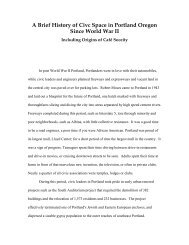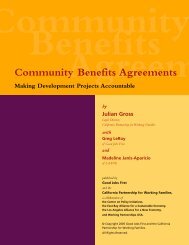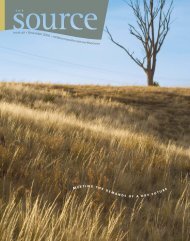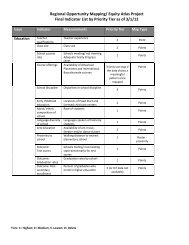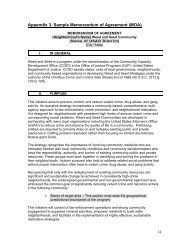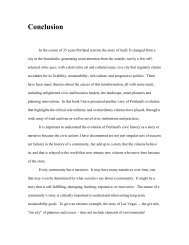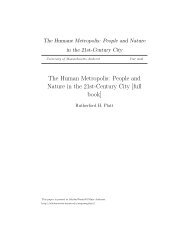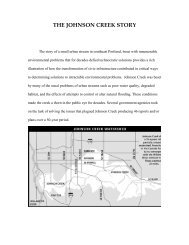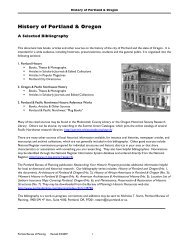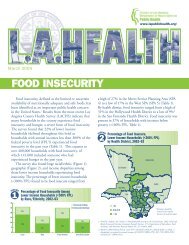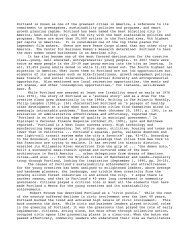Sustainable Portland - Steven Reed Johnson
Sustainable Portland - Steven Reed Johnson
Sustainable Portland - Steven Reed Johnson
You also want an ePaper? Increase the reach of your titles
YUMPU automatically turns print PDFs into web optimized ePapers that Google loves.
<strong>Sustainable</strong> <strong>Portland</strong><br />
What We Need Is a City That Can Carry Us into the Next Century<br />
by <strong>Steven</strong> Ames<br />
at the base of one of the nation's most This would be the equivale.nt of adding a<br />
See simplicity in the<br />
fertile<br />
complicated.<br />
valleys, boundecl bv a great ncw city to the region. onc third again<br />
Achicue Srcatness in little f/rilqs.<br />
watcrwav, this urban regiorrs rt-markallv<br />
portlrnd,<br />
well dtfined We are a plact- apart. by the 1,ear 2000. Most ,rf ther" people<br />
Irrger than the t'ntire citv of<br />
-Lao Tsu<br />
C)ur awarerress of our "portlarrclne.is" rs would rnigrate from other parts of the<br />
ke-en. in the local language, "Easr" can courlr_ry, seeking jobs,<br />
In May<br />
housing<br />
of tggt a survey of planners,<br />
and the<br />
rnearr anvthing f rorn The Dalles tcr good lifc for which<br />
architects and universitv professors<br />
tht' region ls so well<br />
on Atlantic Citr,,. We have our own spectacular<br />
setting, our own varied anc.l trcltrvccl placc.. the world<br />
knor^"'n. And beyonci<br />
the future<br />
our boundaries<br />
of American<br />
of<br />
ciii"r *os or.,b-<br />
Iished<br />
is lunging<br />
in Next<br />
headlong<br />
Magazrne.<br />
into<br />
The conclrrsion,<br />
as usual,<br />
climatt- anr.l, not surprisinglv, our olvrl lalge-r crises. Itegardlcis ,,i ho*<br />
left little<br />
*.ij<br />
doubt<br />
*.<br />
as ro how unique historv. Put differentlr,, the bnng our clwn house<br />
the<br />
into<br />
experts view<br />
order,<br />
<strong>Portland</strong>.<br />
thcre<br />
Among the <strong>Portland</strong> area has c sense of pl,rce.rhorrr<br />
55 Iargest cities in rhe nntion, poriland<br />
willbe no avoiding the impacts of these<br />
it. Should anvone be surprised if over interregional<br />
was ranked second for its overall iuture years<br />
prospects. It was also judged<br />
the.<br />
we inight learn ro sec<br />
most<br />
things<br />
and international developrnen<br />
ts.<br />
differently . . . or sornetimes do them In all likelihood,<br />
attractive<br />
the corning;<br />
city for<br />
decade<br />
its size and finished bettt-r i'<br />
will Jcrrrirntl rhat<br />
close<br />
rhc<br />
to the top among trend-setting Why []eople oI thc<br />
is this elusive qLrality, a sense of Portlrnd rrea rrraxirniz(,<br />
cities, best-managed<br />
the resourcesvct<br />
honor thc<br />
cities and best cities place, scl valuable? Because it is a refercncc<br />
point -borh a perspective ,,n th., region. This challenge<br />
ror<br />
lir.nitations-of<br />
retlrement.<br />
our own<br />
Here was<br />
will<br />
yet<br />
require<br />
another in<br />
all<br />
a string of lrrger wtrrld arounti us anJ c platf orru the skills, determin;ion,<br />
accolades for <strong>Portland</strong><br />
crearrvlty,<br />
and environs, an for iocal action. Held rightly, a sense of ca ring and gutsiness<br />
urban region<br />
we<br />
already<br />
can muster<br />
highly<br />
tc)<br />
touted for placc is a rool for iraming those biggerthan-we-care-to-imagine<br />
problemslnd erccustomed.<br />
p.,ull it off in<br />
its<br />
the stylt'<br />
quality<br />
ro which<br />
of life and<br />
we are<br />
livability. No<br />
doubt, some of the more visible portland<br />
Morc than ever, we wili<br />
bringing them back down to local scale. need to hone this<br />
area achievements<br />
special tool, our<br />
over<br />
sense<br />
the last decade It helps us to focus our awaren€.ss on or place.<br />
have helped win such generous praise: who we are, where we are headecl, and<br />
the nation's first intentionallv desiened what our next steps might be. In so Driving Forces<br />
mass transit<br />
in the<br />
mall,<br />
1980s<br />
the first rnaior ciivwide<br />
energy conservation policv, the solutions are those that can be founc-l in The 1980s<br />
doing, we often discover that the best<br />
first<br />
are' increasingly<br />
publicly<br />
be ing<br />
elected regional<br />
acknowledged<br />
irs a pe.riod<br />
gou*rnmenr,<br />
a<br />
our own back yards.<br />
of it..tt"trr"<br />
new lighr<br />
n"*<br />
rail transit line, and a In <strong>Portland</strong>, what happens locallv pressures for this<br />
host<br />
narion.<br />
of less<br />
Like<br />
prominenr<br />
a plains<br />
but equally matters. In the last decade our awareness<br />
of this has given us a subtle advan-<br />
Iong beiore it hits. Economists,<br />
thunderstorm,<br />
impressive<br />
\ve can fec.l it<br />
innovations.<br />
coming<br />
Why <strong>Portland</strong>?<br />
poliiicians,<br />
and<br />
What makes us so tage in controlling pointless [rcewa1,<br />
prone<br />
other observers<br />
to succeed<br />
of the<br />
?<br />
American<br />
system do not<br />
One could argue expansion, srrengthening our neighborhoods<br />
and conserving energy. What is rurnblings on<br />
endlessly-and<br />
openly savor the<br />
many pe.rple do-as to<br />
whether<br />
the horizon<br />
it is dynamic<br />
of the new<br />
ieadership or an hard to imagrne happening in a hurrdred decc.lc. Privatelv.<br />
active<br />
lnan\'of<br />
citizenry<br />
them<br />
or anv<br />
express<br />
number of other other sprawling urban regions sonretirnes<br />
sec-ms to come naturally to us. not far behind in<br />
doubt anJ cyrricism.<br />
factors.<br />
The<br />
But<br />
ptrhlic<br />
this line<br />
itself is<br />
of argumenr altogether<br />
its perception that<br />
bypassesome of tf,.<br />
Thus far, as the experts agree, we have uninvited changes<br />
indigenous<br />
are in<br />
qualities at work. -o..<br />
the works.<br />
One such been much more fortunate than r-nost. During the<br />
quality,<br />
1950s and<br />
so pervasive<br />
1960s,<br />
and yet<br />
according<br />
so subtle, But wc are not magically immune to<br />
is rarely if ever acknowledged: portland<br />
to opinion polls, Americans characteristically<br />
the many headaches facing urban America.<br />
The <strong>Portland</strong> region, for exarnple, is better than the<br />
is<br />
believed<br />
a successful<br />
that the present<br />
place because<br />
was<br />
it is a distrnct<br />
recent<br />
place.<br />
port and that the<br />
projected to expand by another half-million<br />
people in the next twenty years. over the present. Writ large, this<br />
future would represent<br />
Tucked between<br />
an inrprovement<br />
two mountain ranges,<br />
was<br />
37
Mumford to City Club: Are You Good Enough for Oregon?<br />
The time was Ju\y,7938. The place was the Crystal Room of the Benson<br />
Hotel at the regular Friday luncheon meeting of the City CIub of <strong>Portland</strong>.<br />
The speaker was Lewis Mumford, the great social thinker and conscience of<br />
the urban American landscape, Mumt'ord had been touring the <strong>Portland</strong><br />
region and was aisibly impressed with its aloesome nattrral setting-the<br />
bountit'ul trees, mountains and the Columbia Gorge. His message, characteristically<br />
probing, had that prophetic quality which becomes obaiotrs onlq<br />
after a considerable span of elapsed time:<br />
"l haae se.en a Iot of scenery in my lif e, but I haue secn nothin,q so tcmpting<br />
as a,home t'or man as this Oregon countrv.... You haue here a basis for<br />
ciailization on its highest scale, and I am going to ask you a question which<br />
you may not like. Are you good enottgh to haae this country in your possession?<br />
Haae.you got enough intelligence, imagination and cooperation umong<br />
you to make the best use ot' these opportunities/<br />
"Rebuilding our citieswillbe one of the major tasks of the next generation.<br />
While people are g;rasping f or personal gain the necessary cooperatiae spirit<br />
f or this task cannot deaelop. . . . In proaiding f or new deoelopments you haae<br />
an opportunity here to do a job ot' city planning like nowhere else in the<br />
world. Oregon is one of the last places in this country where natural resources<br />
are still largely intact. Are you intelligent enotrgh to use them<br />
wisely/"<br />
Shortly at'ter Mumt'ord's uisit to <strong>Portland</strong> the Second World War besan,<br />
and follotoing that came an era ot' unparalleled expansion, dominated by<br />
automobiles, t'reeways and parking lots. Lewis Mumf ord's address to the<br />
City CIub was t'iled away f or history and he u)as neuer int,ited hack.<br />
the essence of traditional American<br />
optimism. But in the early 1970s that<br />
historic pattern began to shift, and by<br />
7978, for the first time according ro the<br />
poils, the pattern had reversed c6mpletely.<br />
Americans believed that the past<br />
was better than the present and that the<br />
future would only get worse. American<br />
optimism seems more and more to be a<br />
scarce commodity.<br />
What are the changing social circumstances<br />
that evoke such lowered exDectations?<br />
One might guess thar peopl; have<br />
been reacting to prevailing conditionsinflation,<br />
unemployment-things we<br />
have been told are cyclical and which<br />
will eventually go away. Unfortunately,<br />
the evidence has been filtering in for<br />
some time that such problems are only<br />
the symptoms of larger, structural<br />
conditions in the industrial system, or<br />
even the environment at large-things<br />
that will not go away with a change of<br />
administrations in Washington, nor be<br />
fine-tuned into oblivion. Americans are<br />
not that imperceptive. Our whole way<br />
of life appears to be undergoing some<br />
kind of major shift.<br />
Economist Robert Theobald has<br />
captured some of these larger conditions<br />
in his concept of "driving forces." Put<br />
38<br />
simply, a driving force is a societal trend<br />
whose occurrence is extremelv probabie.<br />
A driving force will not likely be ahered<br />
no matter how we respond to it; it can<br />
only be acknowledged, adapted to, dealt<br />
with. Several rnajor driving forces, says<br />
Theobald, are in effect today that will<br />
have a sustained impact on the United<br />
States through the rest of the century.<br />
These include structural changes in the<br />
social system forced by past population<br />
growth, continued population migrations<br />
within the country, strong ecological<br />
pressures to mitigate the environmental<br />
irnpacts of industry, rapid decline<br />
of inexpensivenergy and resources,<br />
and acceleratedevelopment of telecommunications<br />
and microelectronic innovatlons.<br />
Of all these trends, perhaps none will<br />
have as immediate an impact on the<br />
American lifestyle as the'decline of<br />
inexpensive, nonrenewabl energy and<br />
resources. Dr. Ian Adams, an urban<br />
geographer and longtime observer of the<br />
<strong>Portland</strong> area, has analyzed this trend in<br />
his new book, The Land of Opportunity<br />
in the Age of Limitations. During the<br />
postwar period (7945-7970), he says,<br />
American technology and capital were<br />
utilized to exploit worki resources on a<br />
massive scale. In fact, more energy and<br />
minerals were consumed by Americans<br />
in those 25 years than all nations in a//<br />
of history up to rhat time. The dominant<br />
political value during this period was<br />
what Dr. Adams calls a "politics of<br />
Yes." The polirical sysrem openly<br />
promoted access to abundance for most<br />
individuais as well as large corporare<br />
interests. The result was a material<br />
standard of livrng unmatched by any<br />
natron on earth.<br />
That era of abundance, Adams says<br />
flatly, is now dead. The United States is<br />
being draggecl into a world economic<br />
system where such driving forces as a<br />
declining resource base and accelerated<br />
population growth have intensified<br />
competition and inflated energy cosrs<br />
tremendously. As these impacts ripple<br />
through our economy, tht'American<br />
standard of living relative to other<br />
nations is beginning to decline and our<br />
predominance in world markets is<br />
eroding. A "politics of No," not r.rnlike<br />
the austerity politics of Britain, is<br />
emerging in the American system.<br />
Initially, this may rranslate into the<br />
current cutbacks in federal governnlent<br />
programs and services. Ultrmatelr'.<br />
Adams concludes. it will mean an increasing<br />
denial of access to abundance,<br />
particularly for individual taxpayers and<br />
citizens.<br />
One of the most telline fatalities of<br />
this decline in abundance will be our<br />
historic patterns of development. In the<br />
postwar era, American-stvle development<br />
capitalized on cheap'energy,<br />
abundant land and lavish personal<br />
mobility. The automobile dominated<br />
our lives in every imaginable way. Our<br />
cities and especiallv our suburbs-those<br />
agglomerati-ons of jow-den sity dwelling<br />
units often miles from schools, stores<br />
and jobs-reflected the reality of a<br />
resource-rich society. But such development<br />
patterns were rife with hidden<br />
costs. By way of example, the small<br />
farms of the fertile Tualatin Valley,<br />
which up until World War II had 6een<br />
<strong>Portland</strong>'s main source of food, began to<br />
disappear in the posrwar era. Frorn"1940<br />
to 7978 total farmland in Washington<br />
County declined by 38 percent-a<br />
decrease mainly attributable to rapid<br />
suburbanization.<br />
In the emerging age of limitations,<br />
inflated land, energy and construction<br />
costs-along with interest rates-are<br />
shattering such extravagant options. In<br />
197\, for example, 45 percent of Americans<br />
could afford to enter the new
single-family housing market; by 1981,<br />
that number had shrunk to 11 percent.<br />
If gasoline costs are any indicaior, this<br />
trend will only intensify. In.1971 the<br />
average cost of a gallon of gas in the<br />
U.S. was $.25; by mid-1981 that cost<br />
had risen to $1.16. By the beginning of<br />
the next decade, according to one industry<br />
forecast, the cost of gasoline, in 1990<br />
dollars, will be $10.00 per gallon. At<br />
these figures, the prototypical <strong>Portland</strong><br />
"Street of Dreams" will be a thing of the<br />
past; a duplex in town and a moped in<br />
the driveway may look luxurious.<br />
The point is self-evident: the way in<br />
which the <strong>Portland</strong> area provides for its<br />
people and accommodates new growth<br />
will, of necessity, change radically. A<br />
new premium will be pur on low-cost,<br />
resource-conserving solutions. This<br />
lesson will not only apply to housing<br />
and transportation, but to employment,<br />
education, health care and dozens o{<br />
other life support systems caught in our<br />
society's transition from an age of<br />
abundance to one of limitations. The<br />
real limits to growth are well upon us.<br />
This sobering fact is, pure and simple,<br />
the fabric of the coming decade.<br />
Thinking Globally, Acting Locally<br />
<strong>Portland</strong> is not alone in facing this<br />
predicament-nor hardly the most<br />
seriously affected. The interplay of<br />
driving forces creating these local conditions<br />
is now manifest worldwide. Acknowledgement<br />
of this fact came from<br />
none other than the U.S. government<br />
itself last year with the release of its<br />
GIobal 2000 Report to the President.<br />
Admittedly flawed, this study was<br />
nonetheless the first attempt ever of a<br />
major governmenr to systematically<br />
analyze the impact of world trends.<br />
Examining such factors ai population,<br />
resources and the environment , Global<br />
2000 underscored the fact that a coming<br />
global crunch is highly probable.<br />
According to its findings, there will be<br />
5.35 billion people worldwide in the<br />
year 2000. All trends indicate that the<br />
resources required to sustain that population-given<br />
the existing international<br />
economic system-will not keep pace.<br />
The burden will inoeasingly be foisted<br />
upon the poorer nations and peoples of<br />
the world. For example, the study<br />
predicts the world's supply of arable<br />
land will increase only four percent by<br />
the year 2000 and regional water shortages<br />
will become more pronounced. Soil<br />
erosion will create new desert land<br />
equivalent in size to the srate of Maine<br />
every year, while an area half the size o{<br />
California will be deforested annuallv.<br />
Food supplies will increase only 15<br />
percent by the year 2000 and become<br />
increasingly maldistributed, leaving<br />
millions more in the Third World ficing<br />
the prospect of famine. World oil production,<br />
upon which such supplies have<br />
become overdependent, will begin<br />
dropping off after 1990, with industrialized<br />
nations dominating the market for<br />
these and all other scarce resources.<br />
The warnings of Global 2000, and irs<br />
kindred studies, are so staggering they<br />
tend to elude our comprehension. We<br />
are alternately horrified or numbed. But<br />
the important message is not so much<br />
one of numbers and trends as it is of<br />
scale and interdependence. The growing<br />
industrialized demands on the world's<br />
carrying capacity are not sustainable. As<br />
a result, the problems confronting the<br />
nations of the world, both rich and poor,<br />
have become precarrously intertwined.<br />
Since 1923, the fast lane politics of<br />
world oil markets alone have demonstrated<br />
this fac time and again.<br />
There is, however, another side to<br />
this global condition. The spread of<br />
electronic media, satellites and relecommunications<br />
have helped pull down the<br />
barriers that obscure these dangerous<br />
trends. Nations today are more immediately<br />
in touch, more connected in their<br />
awareness of our tenuous predicament<br />
than ever before. For the first time,<br />
people everywhere have the ability to<br />
identify a common goal for humankind:<br />
survival. In short, we have become the<br />
citizens of a planet.<br />
The great paradox is that there's not
z<br />
k<br />
::!l<br />
"r{i<br />
40<br />
CI.FJ<br />
lnu+<br />
we can actually do at a global processrng and transportation<br />
levei, barring a unified<br />
costs<br />
world"order<br />
;<br />
or carpools and alternatives<br />
some undreamt<br />
to driving<br />
of rechnological<br />
cut<br />
breakth<br />
back on air pollution and<br />
rough. In tru th, there's n"o such th jne<br />
reduce th"e<br />
need ro import oil.<br />
as the quick, global fix. The global<br />
For these and a host of other community<br />
self-help activities, the aggregate<br />
condirion is too multi-dimensronal ro<br />
respond to slam-bang solutions. It will impact is to reduce the escaiatine demand<br />
ior resources thar feeds tfre exist-<br />
only be through a multitude of diverse,<br />
localized strategies, each carried out ing global condition. More important.<br />
with awareness of its larger context, that perhaps, all these acions work together<br />
we will come together to alter the course to reinforce self-determination atlhe<br />
of the planet in the next 20 years. As local level. People exercrse grearer<br />
Ren6 Dubos first said, we must rhink control over their lives. Communities<br />
globally and act locally.<br />
become more self-reliant. The world is<br />
In Toronto in 1980, the First Global not nearly so intimidating a place. We<br />
Conference on the Future-the larsest can look forward again to the year 2000.<br />
intcrnational symposium on the hu"mun<br />
prospecto date-chose as its theme The Evolving <strong>Portland</strong> Vision<br />
Dubos' simple maxim. It was by no<br />
means a coincidence. The trend toward <strong>Portland</strong> already has a certain tradition<br />
localization, though still something of a for looking forward. This was symbolized<br />
in its early days by its experience<br />
clark horse, is becoming elre.y bit ai<br />
important as the trend headed in the with such visionary planners as<br />
opposite direction. "What<br />
John<br />
is happening,"<br />
said conference speaker and futur-<br />
their elaborate visions were, unfortu-<br />
Olmstead and Edwaid Bennett. but<br />
ist Roy Amara, "is that we are beeinning<br />
to tackle problems at grass-r;ots growth and change over the vears was<br />
nately, seldom realized, and the city,s<br />
levels, restructuring institutions with haphazardly inspired b.v proiit and<br />
which we are directly in contact, lnltiating<br />
changes from the bottom up. In fact. ture in American histor1., Lewis Mum-<br />
ambition. In 1938, an important iunc-<br />
participatory movements of all kindsthe<br />
world over-are iikell' to become <strong>Portland</strong>ers to plan more wisely for their<br />
ford visited rhe area andcautioned<br />
one of the dominant transforming forces<br />
in the remainder of the 2Oth centirv. " future. "You have a basis here for<br />
civilization on its highest scale,', he said.<br />
Another conference participant, Bruce "Are you good enough to have this<br />
Stokes of the Worldwatch Institute, has country in your possessron?"<br />
since then authored a book, Helping But Mumford, who once said that<br />
Ourselaes: Local Solutions to Global freeways could only widen chaos, was<br />
P.roblems. that begins to give measure to spurned in favor of the prophets of<br />
this new trend. Local self-help, first and mobilitv. In 7943, <strong>Portland</strong> adopted the<br />
foremost, is cited as the natuial response citv plan of mega-developer Robert<br />
of individuals and communities to make Moses. As historian Dick pintarich<br />
ends meet, gain a sense of control, or notes, the Moses plan was not intended<br />
rnerely survive in a world gone awry to make <strong>Portland</strong> livable as much as to<br />
with unsettling changes. Rfter all, it is make it driveable. As a result, portland<br />
on the local Ievel, as Stokes points out, in the postwar era was rineed with<br />
that the consequences of global problems<br />
are the most obviou!, the motiva-<br />
nation took to wheels on inerpensive<br />
freeways and massive brid"ges as the<br />
tion to solve them most direct, and the gas.<br />
benefits of action most immediate. By the 7970s, however, the free ride<br />
When hundreds and thousands of came squealing to a halt, as area neighborhoods<br />
rose up to fight the blatant<br />
such locaiized actions take place-as is<br />
now beginning to happen-larger destruction imposed upon them by<br />
solutions emerge: weatherization to cut treeway construction. Some large<br />
energy costs at home becomes one of projects were abandoned in their entirety.<br />
Amid signs that rapid. unplanned<br />
society's cheapest "new" sources of<br />
energy; housing rehabilitation and growth was whittling away ar the region's<br />
quality of life, a new resolve ro<br />
neighborhood revitalization creare<br />
affordable alternatives ro expensive new plan ahead and think long range began<br />
suburban development and iontinued to appear. A great deal of this spirit<br />
urban sprawl; community gardens and emanated from portland Citv Hall. but<br />
local food buying clubs reduce food it also involved citizens' task forces.<br />
importation and avoid unnecessary neighborhood activists, historians,
entrepreneurs and the wider public. It<br />
was as if Mumford's challenee had<br />
finally registered.<br />
During this time Oregon's famed new<br />
land use planning law came into existence,<br />
setting into motion a statewide<br />
process that culminated in the preparation<br />
of 277 local comprehensive plans.<br />
<strong>Portland</strong>'s Comprehensive Plan was an<br />
awesome three-year undertaking,<br />
designed to provide a total framework<br />
for land use and developmento the year<br />
2000. Uniike the Moses Plan, which had<br />
been drawn behind closed doors, this<br />
new effort involved the city's neighborhoods<br />
and literally thousands of people<br />
in reviewing plan alternatives. But some<br />
of the plan's more controversial elements,<br />
such as increased housing densities<br />
in the ciry, set up a divisive iug of<br />
war between neighborhood groupJand<br />
city planners. Despite irs intent to<br />
strengthen urban neighborhoods and<br />
encou rage transportation alternatives,<br />
the Comp Plan did not go much beyond<br />
providing a flexibie set of guidelines. It<br />
was criticized for lacking a true sense of<br />
vision for the city's future. The othcr<br />
plans that combined with <strong>Portland</strong>'s to<br />
fill in the region's urban growth boundary<br />
were no different.<br />
What the land use planning process<br />
alone seemed incapable of providingdefinitive<br />
acrion-was redeemed bv a<br />
series of cirizen task forces and stuiv<br />
groups throughour rhe decade. The-<br />
Tri-County Local Government Commission<br />
(7975-76) initiated the formation<br />
of Metro as the first part of a twotier<br />
government reform scenario. The<br />
city's Energy Policy Steering Commitree<br />
(1978-79) resulted in the establishment<br />
of a "one-stop" Energy Savings<br />
Center to promote conservation and<br />
low-cost weatherization. Additionallv.<br />
rhe Metropolitart Directions Tg,vu srudy<br />
(19791 indicated how rich in potential<br />
new solutions Greater <strong>Portland</strong> really<br />
was. Among other things, this survey of<br />
the area's progressive leadership recommended<br />
a regional growth policy based<br />
on a "carrying capacity" approach,<br />
programs designed to reduce peak hour<br />
traffic and discourage the use of auto-<br />
Community Self-Help: An Idea Whose Time Has Returned<br />
Long before government assumed responsibility<br />
for social problems,<br />
neighborly good will and local selfreliance<br />
were community standards.<br />
Families, churches, neighborhoods<br />
and voluntary groups-all essential<br />
to a vital democracy-stood between<br />
the individual and the large institutions<br />
of public life.<br />
But in the two centuries since the<br />
American Revolution our society has<br />
grown more complex and our problems<br />
more resistant to solutions.<br />
Government attempts to provide answers-growing<br />
out of the New Deal<br />
era of the '30s and expanding in scope<br />
for nearly half a century-are now<br />
being withdrawn. Conservarives justify<br />
cutbacks in social programs on<br />
the grounds that extensrve government<br />
involvement has failed to provide<br />
solutions and has created iclients<br />
of the state." Liberals counter<br />
that social cutbacks severely harm<br />
those people least able to provide solutions<br />
on their own. Disillusionment-among<br />
people of every political<br />
stripe-is now general, and the<br />
need for a fresh approach to community<br />
concerns grows increasingly eviclent.<br />
As Bruce Stokes of the Worldwatch<br />
Instirute notes in his book,<br />
Helping Ourselaes,<br />
By breaking up issues into their<br />
component parts and dealing<br />
with them at the local leuel, interdependent<br />
problems can once<br />
again become manageable . . . if<br />
indiuiduals and communitieis<br />
are to gain greater control oaer<br />
their liues, then they mtrst do so<br />
by emp owerin g th ent s elu e s.<br />
.Over the past 15 years, a new type<br />
of structure-the community-based<br />
organization (CBO)-has emerged<br />
throughout the country as an important<br />
source of innovation and institutional<br />
change. CBO's are in the best<br />
American tradition of neighbor helping<br />
neighbor. They involve people di,<br />
rectly in working for the betterment<br />
of their local community, working<br />
for the adoption of needed legislation<br />
(citizen participarion) and actually<br />
administering neighborhood projects<br />
(community self-heip) . The roots of<br />
some of the most successful urban revitalization<br />
efforts are here: alternative<br />
schools, consumer co-ops, urban<br />
homesteading programs, crime<br />
watch block clubs, appropriate technology<br />
projects and community developnten<br />
t corpora tions<br />
However, as Bruce Stokes also<br />
points out, self-help activities do not<br />
take place magically on their own.<br />
The role of government is vital to<br />
tnelr success.<br />
In the minds ot' many people<br />
there is an inherent contradiction<br />
in gouernment support for<br />
self-help actiaities. Accordins to<br />
this aiew, Iocal endeat,ors ia,<br />
only succeed if they are t'ree<br />
lrom goa ernment interoention.<br />
This distinction, while ideolosically<br />
neat, is not appropriate t'or<br />
the complex issues facing society<br />
oaer the next few decades.<br />
Community self-heip efforts require<br />
experiments and learning processes<br />
that take time to evolve. Community-based<br />
initiatives often seem<br />
to be stymied rather than encouraged<br />
by public officials. Despite lofty rhetoric,<br />
nowhere in either current federal<br />
or state government proposals is<br />
there a menrion of strong policy commitments<br />
and communitv capacitvbuilding<br />
efforts lseed funjing, truining<br />
and technical assistance) designed<br />
to assist citizens to help themselves.<br />
In <strong>Portland</strong>, there are some encouraging<br />
signs. Several city commissioners<br />
have been exploring ways<br />
to stimulate self-help efforts. The<br />
Housing and Community Development<br />
office has also been working on<br />
a process to establish a neighborhood<br />
self-help demonstration prog.u*.<br />
If self-help projects are to succeed,<br />
they must be controlled by the people<br />
they're designed to assist and be<br />
based upon local partnerships among<br />
government, private business and<br />
community groups. Local government<br />
can play the crucial role of<br />
"enabler" by providing incenrives<br />
and adopting policies that promote<br />
dialogue and cooperation ar the<br />
neighborhood level.<br />
-Steae Rudman<br />
47
o<br />
0q<br />
@<br />
v)<br />
sl',' ,ll<br />
r, rrr;:;lirt!f::ii :<br />
:ili"<br />
I<br />
tj lfl',.,:.:,::<br />
A reflectton of the City Beautiful movement, Edward Bennett's 1912 plan for the city envisioned a<br />
stately boulevard running from West Burnside to a new Union Station<br />
mobiles, local neighborhood enhancement<br />
efforts to mirigate the negative<br />
effects of higher densities, and consideration<br />
of a three-tier government in the<br />
metropolitan area- regional, municipal<br />
and neighborhood.<br />
But the question of a long-range<br />
visjon for the community-anricipating<br />
where we actually wanted <strong>Portland</strong> to<br />
go, rarher than being bullied along by<br />
trends and crises-was never really<br />
addressed until the Citv Club of <strong>Portland</strong><br />
formed its Vision'Committee. A<br />
direct response to the inadequacies of<br />
the <strong>Portland</strong> Comprehensive Plan, the<br />
Vision Committee accepted testimony<br />
from expert witnesses and conducted<br />
polls on-a positive direction for the city's<br />
{uture. And. in a departure from the<br />
traditional role of reviewing and reporting,<br />
it recommended that the City Club<br />
4')<br />
ffi<br />
d.<br />
,ru<br />
sjr,<br />
' j*,<br />
i-'+<br />
take an active leadership role in implementing<br />
its recommendations. The City<br />
Club agreed. Ir was a distinct commirment<br />
to the visioning process.<br />
The committee's Report on a Vision<br />
of <strong>Portland</strong>' s Future {1980), while<br />
recognizing the realities of a growing<br />
local population, diminished resources,<br />
inflated costs of goods and services and<br />
the forcing effect of all these things on<br />
living and decision-making at the local<br />
level, offered a potential vision for a<br />
different <strong>Portland</strong> in the vear 2000.<br />
supported by scores of mini-visions. The<br />
Vision Reporf also made a serious<br />
attempt to assess the impact o{ "emerging<br />
issues" on the area, particularly the<br />
revolution in telecommunications and<br />
the implications of moving information<br />
rather than people. It was the first time<br />
any citizen's study in the community<br />
had taken such an approach. Its aggregate<br />
vision for the city was positive,<br />
humanistic and noticeably decentralized.<br />
Included among its-glimpses of<br />
<strong>Portland</strong> 2000:<br />
. The city, in large part, will become<br />
a transit- and pedestrian-oriented place,<br />
with small cars used for occasional<br />
personal or business trips, and bicycles<br />
and mopeds common as auxiliary transportation.<br />
. The intelligent use of interactive<br />
cable TV and computers will expand<br />
public knowledge of major issues and<br />
increase the public level of parricipation<br />
in the government process.<br />
. Small, clean, low-capital and low<br />
traffic businesses will be run from<br />
private homes or from other locations<br />
within the district, relying on communications<br />
technology and advanced electronics<br />
in their operation.<br />
. Condominiums and other cooDerative<br />
forms of ownership will increise.<br />
being built as planned unit developments<br />
to offer the amenities of lower<br />
density housing to residents and neigh-<br />
DOrS.<br />
. Schools will be expanded into<br />
full-time, multi-service community<br />
centers to offer, among other things,<br />
day-care, drop-in centers for the elderly,<br />
computer terminals for those<br />
without home access, and personal and<br />
vocational counseling.<br />
' "Wellness Clinics" will be a part of<br />
neighborhood community ..nt.rr,<br />
where the emphasis will be on encouraging<br />
and maintaining physical and mental<br />
health through a variety of programs.<br />
The disarming quality of such rich,<br />
literal images was that once they had<br />
entered the public consciousness, they<br />
became impossible to ignore. <strong>Portland</strong>'s<br />
legitimate concerns for the future could<br />
be seen in a newer context. Solutions of<br />
a different order were conceivable. It<br />
was in this way that the Vision Report<br />
began to nudge many civic leaders into<br />
the realm of the possible. It was a clear<br />
demonstration that a positive vision of<br />
the future could act as a catalyst for the<br />
necessary change.<br />
What was now needed was a way to<br />
draw the wider community and region<br />
into an actual visioning process for the<br />
area. Government alone could not do it<br />
because it had limited ability to plan and<br />
innovate new directions and even less<br />
assurance of widespread public support.<br />
At the same time, the manv local citizen<br />
and private sector efforts to innovate<br />
change would easily remain ineffective
ecause they lackcd visibilitv, a comprehensivc<br />
oven icw, or the support of<br />
rr'sponsive public polrcv. lt was only in<br />
llnking long-rangc plannrng with hioadbased<br />
citizen education and action that a<br />
true vision for the communrty could be<br />
dcvelopctl. As we cnterrd rhe lC80s,<br />
with every indication thar they would be<br />
as challengrng as had been promiscd,<br />
burlding a common vision for the future<br />
of <strong>Portland</strong> waited on the public agenda.<br />
The <strong>Sustainable</strong> City<br />
The Chincse have a fascinating character<br />
for the concepl of crisis. Actually, it is<br />
two characters drawn together, one<br />
meaning danger and the other opportunity.<br />
In itself , it is a sublime refiection<br />
on the paradox of life and potential<br />
choice to be iound rn any situarion of<br />
great challenge. It could also be seen as a<br />
fitting metaphor for the challenge our<br />
society faces in 1982. for Ameriians, it<br />
has become a matter of choosing the<br />
right opportunirics among the manv<br />
dangers conironting us-and moving<br />
with them.<br />
For those people who have long<br />
sensed that this time of choice is upon<br />
City Club to <strong>Portland</strong>: Look Ma, No Wheels!<br />
Ilow times change. Forty some years and inntrmerable t'reewaq olterpasses<br />
after the aisit.of Lezois Mumford to portland, the thritt of the g'reat postwar<br />
auto boo.m i.s beginni,ng to wane. Gasoline prices haae jumped"oaer 3s0 percent<br />
in the last decade, Federal monies t'rom the abanione'd NIt. Hood Freeway<br />
project ar,e no,Lt being used to build the region's new light rail line. And<br />
the City CIub has released its Report on a visiJn of portlan j,s rut,r.., detailing<br />
in its scenarios how the telecommunications reaoltrtion zoill open up nezu<br />
f orms,ot' electronic "mobilitu" uhile reducing our needs to trattel'. ls nothing<br />
sacre d?<br />
"Year 2000. Southeast port.land . . . Ief f lones is an accountant with a large<br />
f irm in downtown . . . H e works three days a week in the comf ort ot' his den"in<br />
his Mt. scott honte. He 'conrmunicates' io work at the ot't'ice do*nioi:, urrng<br />
telecommu,nications, Iet'f can do basic bookkeeping and research'any rax<br />
questions from his home using a microcom-puteir, is weil as hohl meitings<br />
zuith staf f without l.taping to be in a central location.<br />
"The ot'fice downtown is not the place it was in 19g0. since let'f's t'irm<br />
started using telecornm.unic.atio,s and ot'fering the home-*urkp'lr.i, o, o,<br />
employment option i,t has benef itted in mani ways. By giaing people the<br />
option of working at honte , the of f ice.stat'f wa's cut to a minimuit, requtring<br />
less ice<br />
.of,f<br />
sy.ace and.[reeing f inancial resortrces t'or other actiuities .'..<br />
," Jef t sets his own ltottrs, He is at home when his son Lee comes home t'rom<br />
school and his "childcare" of,ten int:olaes joining his son t'or a jog in the late<br />
at'ternoon. The reduced number ot' trips to'the ofilice t,ow kron't f os and time<br />
saaings for.the loneses and more family use o't' the neighborhSod busmess<br />
district within walking distance of 'theirho^, . . .
us, such opportunities are everywhere mented with integral food, energy and<br />
and all but insurmountable. In recent waste systems; cities that have built<br />
years, almost invisible to the national energy conservation jnto their street<br />
media, a wealth of individuals, ideas and design, zoning and building codes;<br />
experiments has already begun to retool urban regions that are assessing the<br />
or,rr scrcietv for a maior transition - levels of growth and development that<br />
,o.n. *o.rid say transf ormation-f rom can be supported by their air- and<br />
a culture that cannot last our lifetrmes to watersheds; whole states that are being<br />
one that is infinitely sustainable. From studied to determine their ability to<br />
the great thinkers of our time, to people become self-reliant in food production.<br />
simply puttinS in gardens and recycling Make no mistake about it, the transition<br />
their wastc, a quiet movement is emerging<br />
that is giving weight to such a<br />
But, as yet, no major community has<br />
has begun.<br />
transition. And it is a movement big come forward with a new image of itself<br />
enough for everyone because the tasks that intesrates all these ideas and uses<br />
before us are as many as there are that image to build its future. Perhaps<br />
peopie.<br />
Greater <strong>Portland</strong>-with its sense of<br />
What will such a transition look like? place, its search for quality, its openness<br />
For our larger society the images are to change-can be that crty.<br />
unciear, in part because it is not really at<br />
the national level where change is being<br />
forged. But for our regions and localities-for<br />
the <strong>Portland</strong> area-the images<br />
are much more tangible. It is here where<br />
the transition is already underway.<br />
"The '80s," says Hazel Henderson,<br />
author of the new book The Politics of<br />
the Solar Age, "will be a period of<br />
reconceptualization and innovation,<br />
redirected investments, recycling,<br />
redesign for conservation, rehabilitation<br />
and reuse of buildings {or new life,<br />
revival of small towns and srnall businesses,<br />
and resurgence of neighborhood-based<br />
and local enterprises, co-ops<br />
and community development, which<br />
release human energy and potential in<br />
new local and regional economies o{<br />
scale. ''<br />
If there is a larger vision that can<br />
guide <strong>Portland</strong> through this transition,<br />
perhaps it is the image of the sustainable<br />
city-the city that thinks of itself<br />
whole, that moves with change, and<br />
plans for permanence. Above all, this<br />
implit's an acceptance of responsibility<br />
and nurturing of solutions at the local<br />
level: conserving indigenous resources<br />
and managing them for sustained yield;<br />
fostering local productton to meet more<br />
of local needs; designing political sysrems<br />
to support decision-rnaking at the<br />
lowest possible level; and, everywhere,<br />
encouraging low-cost, community<br />
self-help strategies that empower people<br />
to help themselves. The vision is still a<br />
distant one. It may require nothing less<br />
than a reorientation of our values. But<br />
doing such things, a city will survive<br />
and endure.<br />
Pieces of such a vision have already<br />
begun to appear in American communities:<br />
neighborhoods that have experi-



